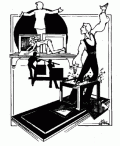Designer: Dante the Magician
The "Backstage" illusion was created by Danish magician Harry August Jansen (1883 - 1955) better known as Dante the Magician. The original idea may have come from British vaudeville comedian, George Robey, who used it circa 1919 as a means to vanish an illustrated elephant. Robey used the idea in his skit for the London review called "Round in Fifty."
Robey's illustrated elephant version worked like this:
The performer offers to teach his audience how to vanish an Elephant. He displays a draped tray, a picture of an Elephant, and two boards to "cage" the elephant. He now turns his back to the audience, and performs the effect for an imaginary audience in front of him, while the real audience has a backstage view of the working.
The two boards are placed on the tray. The Elephant Card is displayed, and dropped between the two cards. The Cards are then removed, and freely displayed on both sides, to show the Elephant has vanished. The real audience however, has seen how the effect is accomplished, because they have seen the Elephant Card drop through a slot in the tray into a ribbon harness under the tray. The Elephant is not visible from the front, being concealed by the drape.
After some remarks to the effect that when performed with a real Elephant one would require, a much larger trap on the stage than the slot in the tray, and a much stronger harness, the performer offers to repeat the effect, this time with the real audience to the front.
The two boards are again placed on the tray, and the Elephant drops between them. The boards are removed and freely displayed on both sides. The Elephant has vanished. The performer explains that there may be a few wise people in the audience who, may figure out that the Elephant is behind the drape. As he says this, he turns the tray around, so that the audience sees the, Elephant hanging in the ribbon harness behind the drape.
If this happens, the performer continues, he has no recourse, except to use some "real magic". The tray is turned, drape side again facing audience. The performer gestures dramatically to make the Elephant vanish, then peels away the drape to show the elephant has indeed vanished. Both the drape and tray are freely shown all sides, with no trace of the elephant.
Clearly, Robey's version was quite different than the actual stage version developed by Dante. Dante first used his version circa 1927 in his Buenos Aries tour.
In Dante's Backstage illusion, the magician apparently lets his audience have a behind-the-scenes look at how he produces his assistant. The illusion is turned around, giving the audience a view from the back and the magician faces the back wall of the stage, performing to an imaginary audience. The audience sees the assistant hiding and sees exactly how the trick works. But, when the production from the box is made, although the audience saw the assistant crawl into the box, she is gone and a man produced instead. The audience has been completely fooled. Later versions (as pictured) typically use two boxes, but Dante's original version used a single cabinet as shown in the Paul Daniel's video.
Photo Credit: Rich Hill (black, red, wood-stained boxes), Magic Makers Inc. (Canada) (red and blue boxes)
https://youtu.be/P-ajvLoZOBk
https://youtu.be/boF4HIYOIIo
SOURCES
When originally researching this information, the Illusion Repository found it in several places but never correctly documented those sources. In revisiting the post to update the sources, unfortunately the only source was the Magic Cafe by a user called Spellbinder. That post can be seen here: http://themagiccafe.com/forums/viewtopic.php?topic=389460
However, we do know this information was originally found elsewhere online and possibly in physical articles not published online. If anyone has better sources, please let us know by contacting us at illusionrepository[at]gmail.com and we will update the listing.



